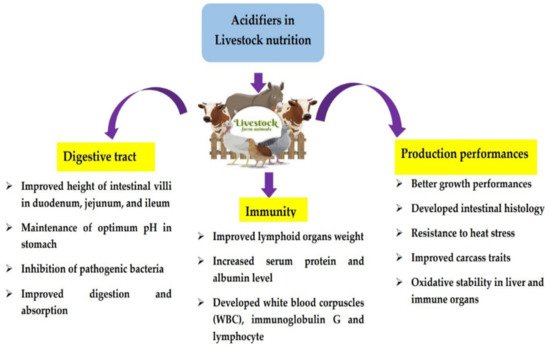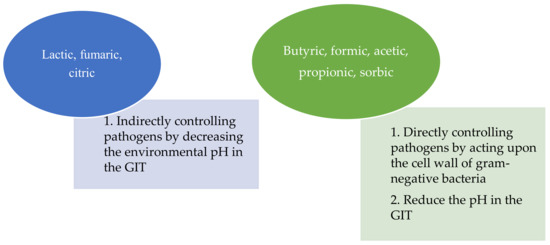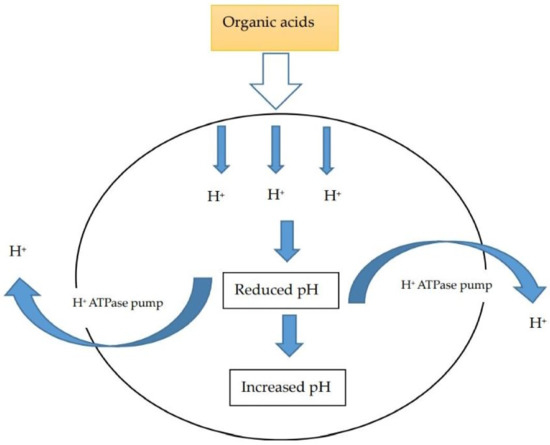Because the application of antibiotic growth promoters (AGP) causes accelerated adverse effects on the animal diet, the scientific community has taken progressive steps to enhance sustainable animal productivity without using AGP in animal nutrition. Organic acids (OAs) are non-antibiotic feed additives and a promising feeding strategy in the swine and broiler industry. Mechanistically, OAs improve productivity through multiple and diverse pathways in: (a) reduction of pathogenic bacteria in the gastro-intestinal tract (GIT) by reducing the gut pH; (b) boosting the digestibility of nutrients by facilitating digestive enzyme secretion and increasing feed retention time in the gut system; and (c) having a positive impact and preventing meat quality deterioration without leaving any chemical residues. Recent studies have reported the effectiveness of using encapsulated OAs and synergistic mechanisms of OAs combinations in swine and broiler productivity. On the other hand, the synergistic mechanisms of OAs and the optimal combination of OAs in the animal diet are not completely understood, and further intensive scientific explorations are needed.
- organic acids
- feeding
- swine
- broilers
- digestibility
- meat quality
1. Introduction

| Acid | Chemical Name | Registration Number | Molecular Weight/GE (MJ/Kg) | Odor | pKa |
|---|---|---|---|---|---|
| Butyric | Butanoic Acid | - | 88.12/24.8 | rancid | 4.82 |
| Citric | 2-Hydroxy-1,2,3-Propanetricarboxylic Acid | E 330 | 192.1/10.2 | odorless | 3.13 |
| Propionic | 2-Propanoic Acid | 1a297 | 74.08/20.6 | pungent | 4.88 |
| Sorbic | 2,4-Hexandienoic Acid | E 200 | 112.1/27.85 | mildly acrid | 4.76 |
| Formic | Methanoic Acid | E 236 | 46.03/5.7 | pungent | 3.75 |
| Acetic | Ethanoic Acid | E 260 | 60.05/14.6 | pungent | 4.76 |
| Lactic | 2-Hydroxypropanoic Acid | E 260 | 90.08/15.1 | sour milk | 3.83 |
| Malic | Hydroxybutanedioic Acid | E 296 | 134.1/10.0 | apple | 3.40 |
| Fumaric | 2-Butenedioic Acid | 2b08025 | 116.1/11.5 | odorless | 3.02 |
| Benzoic | Benzenecarboxylic acid | - | - | - | 4.20 |
2. Potential Modes of Action of OAs
2.1. Effect of OAs on Mineral Utilization and Nutrient Digestibility
2.2. Effect of OAs on Antimicrobial Activity and Pathogenic Bacteria


3. Effect of OAs in Swine and Broiler
3.1. Supplementation of OAs on the Growth Performance of Swine and Broilers
| Dosage and Organic Acid/Acids | Growth Phase | Growth Performances | Intestinal/Fecal Microbial Counts (CFU) | Other Parameters | References | ||
|---|---|---|---|---|---|---|---|
| BWG/FBW | ADFI | G:F | |||||
| Swine | |||||||
| 0.1% and 0.2% fumaric, citric, malic, MCFA (capric and caprylic) | Weaning | S | NS | S | E. coli; S Lactobacilli; S Clostridium; S Salmonella; S |
|
Yang et al., 2018 [71] |
| 0.1% and 0.2% fumaric, citric, malic, MCFA (capric and acrylic) | Growing | S | NS | S | Lactobacilli; S E. coli; NS |
- | Upadhya et al., 2016 [72] |
| 0.15% benzoic, fumaric, calcium formate | Weaning | S | NS | NS | E. coli; NS Lactobacilli; NS |
|
Xu et al., 2017 [73] |
| 1.1% acetic, propionic, phosphoric, citric acid | Weaning | NS | NS | NS | Lactobacilli; NS E. coli; NS Coliforms; NS |
|
Namkung et al., 2004 [74] |
| 0.4% and 0.2% fumaric, lactate, citric, propionic, benzoic acid | Weaning | NS | NS | NS | E. coli; NS | - | Walsh et al., 2007 [56] |
| 0.5% benzoic acid | Weaning | S | S | S | Lactobacilli; S | - | Wei et al., 2021 [75] |
| 0.5, 1% benzoic acid | Weaning | S | NS | NS | NE |
|
Kluge et al., 2005 [76] |
| 0.5% butanoic, fumaric, benzoic acid | Piglets | S | NS | S | Lactobacilli; NS E. coli; NS |
|
Li et al., 2008 [77] |
| 0.1% fumaric, citric, malic, MCFA (capric and caprylic) | Finishing | S | NS | S | Lactobacilli; NS E. coli; NS |
|
Upadhya et al., 2014 [78] |
| 0.85% formic, benzoic, sorbic, Ca- butyrate | Growing male pigs | NS | NS | NS | E. coli; S Lactobacilli; S |
|
Øverland et al., 2007 [79] |
| 0.5% benzoic acid | Weaning | S | S | S | E. coli; NS Lactobacilli; NS |
|
Papatsiros et al., 2011 [80] |
| 0.14% and 0.64% formic acid | Weaning | S | S | NS | Lactobacilli; S |
|
Luise et al., 2017 [9] |
| Broilers | |||||||
| 0.3% and 0.4% calcium formate, calcium propionate 0.3, 0.4% ammonium formate, ammonium propionate |
Finishing | S | NS | S | NE |
|
Saleem et al., 2020 [81] |
| 1% formic, lactic, propionic, citric acid | Finishing | S | NS | NS | NE |
|
Ali et al., 2020 [82] |
| 0.5% citric, sorbic, synthetic essential oil | Finishing | NS | NS | NS | E. coli; NS Enterococci; S Clostridium; NS Enterobacteriaceae; NS |
|
Stamilla et al., 2020 [83] |
| 0.15% formic, lactic, citric, malic, tartaric, phosphoric acids | Finishing | S | S | S | Lactobacilli; S E. coli; S |
|
Goh et al., 2020 [84] |
| 0.3% formic, acetic, propionic, ammonium formate | Finishing | S | NS | NS | NE |
|
Dai et al., 2021 [85] |
| 0.1% lactic, citric, acetic, formic, propionic, phosphoric, and sodium butyrate | Finishing | S | NS | S | Lactobacilli; S Coliforms; NS |
|
Sabour et al., 2018 [86] |
| 0.3, 0.5% formic, propionic acid | Finishing | S | NS | S | Lactobacilli; S E. coli; S |
|
Fathi et al., 2016 [87] |
| 0.06% fumaric, calcium format, calcium propionate, potassium sorbate, hydrogenated vegetable oil | Finishing | S | S | S | Lactobacilli; S Salmonella; S |
|
Hassan et al., 2010 [67] |
| 0.2, 0.4, and 0.6% butyric acid | Finishing | S | NS | S | E. coli; S |
|
Panda et al., 2009 [88] |
| 0.5, 1, 1.5, and 2% citric, lactic, phosphoric acid | Finishing | S | NS | S | E. coli; S Salmonella; S |
|
Sultan et al., 2015 [89] |
| 0.6% formic acid | Finishing | S | NS | S | E. coli; S (in crop) |
|
Panda et al., 2009 [90] |
| 2% butyric, fumaric, lactic, and 3% butyric, fumaric, lactic acid | Finishing | S | NS | S | NE |
|
Adil et al., 2010 [25] |
| 0.2% propionic, 0.3% butyric acid | Finishing | S | NE | S | NE |
|
Lakshmi and Sunder., 2015 [91] |
3.2. Supplementation of OAs on Nutrient Digestibility of Swine and Broilers
| Dosage and Organic Acid/Acids | Growth Phase | Digestibility | Reference | |||
|---|---|---|---|---|---|---|
| DM | N | E | CP | |||
| Swine | ||||||
| 0.2% fumaric, citric, malic, capric, and caprylic acid | Growing | S | S | S | S | Hossain et al., 2011 [94] |
| 0.05% citric, sorbic acid | Growing | S | NS | S | NC | Cho et al., 2014 [108] |
| 2% benzoic acid | Lactating sows | S (OM) | NE | NE | S | Kluge et al., 2010 [99] |
| 0.1% and 0.2% fumaric, citric, MCFA | Finishing | S | S | S | NE | Upadhaya et al., 2014 [92] |
| 0.5% phenyllactic acid | Weaning | S | S | NE | NE | Wang et al., 2009 [109] |
| 0.3% formic, acetic, propionic, MCFA | Weaning | S (DM) NS (OM) |
NS | NS | NS | Long et al., 2018 [110] |
| 0.5% formic, propionic, lactic, citric, sorbic acid | Post-weaning | NS | NS | NS | NS | Gerritsen et al., 2010 [111] |
| 300 mEq acid/kg formic, n-butyric acid | Growing | S | S | S | S | Mroz et al., 2000 [112] |
| 0.15% citric acid | Lactating sows | NE | NE | NE | S | Liu et al., 2014a [95] |
| 0.2% fumaric, citric, malic, capric, caprylic acid | Lactating sows | S | S | S | NE | Devi et al., 2016 [113] |
| Broilers | ||||||
| 0.2% formic, propionic acid | Finishing | NS | NE | NE | S | Emami et al., 2013 [104] |
| 0.5% formic acid | Finishing | NS | NE | NE | NS | Hernández et al., 2006 [101] |
| 0.25, 0.5, and 0.75% formic acid | Finishing | NS | NE | NE | S | Ndelekwute et al., 2015 [114] |
| 5000ppm and 10,000ppm formic acid | Finishing | S | NE | NE | S | Garcia et al., 2007 [101] |
| 0.25% acetic, butyric, citric, formic acid | Finishing | S | NE | NS | S | Ndelekwute et al., 2019 [115] |
| 1, 2, and 3% citric acid | Finishing | NE | NE | S | S | Ghazalah et al., 2011 [69] |
| 0.5, 1, and 1.5% fumaric acid | Finishing | NE | NE | S | S | Ghazalah et al., 2011 [69] |
| 0.25, 0.5% formic acid | Finishing | NE | NE | NS | S | Ghazalah et al., 2011 [69] |
| 0.25, 0.5, and 0.75% acetic acid | Finishing | NE | NE | S | NS | Ghazalah et al., 2011 [69] |
3.3. Effect of OAs Supplementation on Meat Quality on Pigs and Broilers
This entry is adapted from the peer-reviewed paper 10.3390/life11060476
